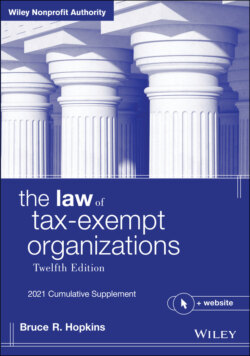Читать книгу The Law of Tax-Exempt Organizations, 2021 Cumulative Supplement - Bruce Hopkins R., Bruce R. Hopkins, David Middlebrook - Страница 12
ОглавлениеCHAPTER ONE Definition of and Rationales for Tax‐Exempt Organizations
§ 1.1 Definition of Nonprofit Organization (a) Nonprofit Organization Defined
§ 1.1 DEFINITION OF NONPROFIT ORGANIZATION
(a) Nonprofit Organization Defined
p. 5, note 7. Insert prior to existing text:
This point is sometimes overstated, as illustrated by a state's supreme court's proclamation that “[n]on‐profit corporations do not have owners,” adding that “non‐profit corporations do not have shareholders or any other way for third parties (whether individuals or entities) to assert a similar ‘ownership’ role” (Farrow v. Saint Francis Medical Center, 407 S.W.3d 579, 593 (Sup. Ct. Mo. 2013)).
p. 5, note 7. Insert as second paragraph:
An individual, desiring to engage in certain activities appropriate for a nonprofit entity, formed, with advice of legal counsel, a nonprofit corporation. Matters did not go well with this entity, programmatically or financially. This individual, who was the corporation's incorporator and president, and a director, filed a retroactive election for S corporation status for the entity as of the date of incorporation. This was done in an effort to enable him to report passthrough operating losses on his personal income tax returns. To this end, he claimed that he held an ownership interest in the organization equivalent to that of a shareholder. The IRS disagreed, disallowing the passthrough losses. The U.S. Tax Court upheld the IRS's position, rejecting the argument that this individual held “exclusive beneficial ownership” of the corporation and writing that “there is no interest in a nonprofit corporation equivalent to that of a stockholder in a for‐profit corporation who stands to profit from the success of the enterprise” (Deckard v. Comm'r, 155 T.C. No. 8 (2020)).
p. 5, note 8, second line. Insert following first comma:
Charleston Area Medical Center, Inc., CAMC Health Education and Research Institute, Inc. v. United States, 940 F.3d 1362 (Fed. Cir. 2019); Wichita Center for Graduate Medical Education v. United States, 917 F.3d 1221 (10th Cir. 2019);
p. 5, note 8, third line. Insert and following semi‐colon.
p. 5, note 8, fourth line. Delete text following closing parenthesis and insert period.
